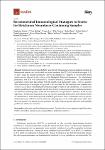Recommended Immunological Strategies to Screen for Botulinum Neurotoxin-Containing Samples
Simon, Stéphanie
Fiebig, Uwe
Liu, Yvonne
Tierney, Rob
Dano, Julie
Worbs, Sylvia
Endermann, Tanja
Nevers, Marie-Claire
Volland, Hervé
Sesardic, Dorothea
Dorner, Martin
Botulinum neurotoxins (BoNTs) cause the life-threatening neurological illness botulism in humans and animals and are divided into seven serotypes (BoNT/A–G), of which serotypes A, B, E, and F cause the disease in humans. BoNTs are classified as “category A” bioterrorism threat agents and are relevant in the context of the Biological Weapons Convention. An international proficiency test (PT) was conducted to evaluate detection, quantification and discrimination capabilities of 23 expert laboratories from the health, food and security areas. Here we describe three immunological strategies that proved to be successful for the detection and quantification of BoNT/A, B, and E considering the restricted sample volume (1 mL) distributed. To analyze the samples qualitatively and quantitatively, the first strategy was based on sensitive immunoenzymatic and immunochromatographic assays for fast qualitative and quantitative analyses. In the second approach, a bead-based suspension array was used for screening followed by conventional ELISA for quantification. In the third approach, an ELISA plate format assay was used for serotype specific immunodetection of BoNT-cleaved substrates, detecting the activity of the light chain, rather than the toxin protein. The results provide guidance for further steps in quality assurance and highlight problems to address in the future.
Files in this item
No license information

